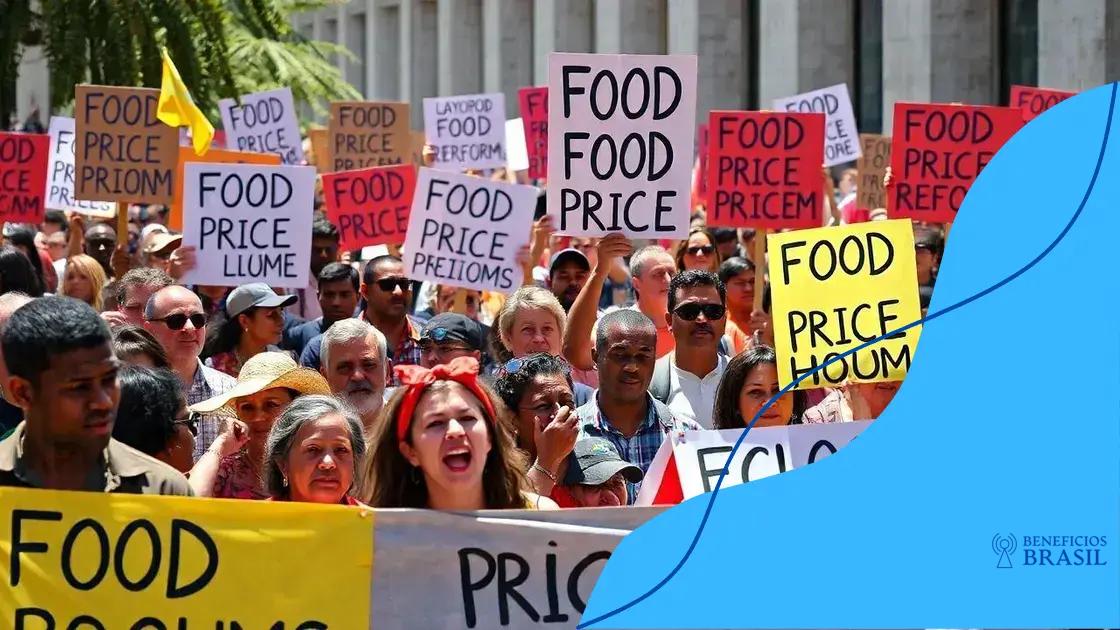Food price inflation protest campaigns spark global change

Food price inflation protest campaigns mobilize communities to advocate for policy changes, improve food access, and create initiatives that address rising costs effectively.
Food price inflation protest campaigns have taken center stage as communities worldwide rally against rising costs of living. These movements reflect the urgent need for actionable solutions to hunger and economic challenges, engaging people like you to participate.
Understanding food price inflation
Understanding food price inflation is essential for grasping its impact on households and economies worldwide. It often feels overwhelming but breaks down into simpler concepts. In this section, we will explore the definitions, causes, and effects of rising food prices.
What is Food Price Inflation?
Food price inflation refers to the increase in the prices of food items over time. This phenomenon can arise from various factors, including supply chain disruptions, rising production costs, and changing consumer demand. Understanding these reasons helps clarify why prices soar, affecting every shopper.
Causes of Food Price Inflation
There are several factors contributing to food price inflation. Here are the most significant:
- Supply chain issues: Events like natural disasters or political instability can disrupt food supply chains, leading to shortages.
- Increased demand: As populations grow, the demand for food rises, pushing prices higher.
- Weather conditions: Unfavorable weather can harm crop yields, resulting in scarcity and increased prices.
- Global market fluctuations: Changes in foreign markets can impact local food pricing significantly.
The implications of rising food prices are far-reaching. For many families, this can mean less food on the table or switching to cheaper, less nutritious options. When prices climb, public outcry often follows, as seen with recent protests advocating for affordable food.
Impact on Households and Communities
The effect of food price inflation on households can be dramatic. Many people may struggle to afford basic groceries, leading to tough choices about spending. In communities, this can result in increased activism as groups rally to demand fair pricing and government action to address food security.
Throughout this article, we’ve looked at how understanding food price inflation not only informs individuals but also stimulates community responses. As you can see, awareness is the first step towards creating a change.
The rise of protest campaigns

The rise of protest campaigns in response to food price inflation highlights a growing awareness among communities regarding economic challenges. People are uniting to demand change, showcasing their concerns through various forms of activism. These modern movements leverage social media, making it easier to spread the word and gather supporters.
Characteristics of Recent Protest Campaigns
Currently, many protest campaigns share common features which make them effective:
- Grassroots organization: Many campaigns start with local groups, empowering individuals to lead the charge.
- Social media engagement: Platforms like Twitter and Facebook allow for quick mobilization and information sharing.
- Emphasis on inclusivity: Campaigns encourage participation from diverse community members, strengthening their impact.
- Creative expression: Through art, music, and performances, movements convey powerful messages that resonate with many.
Throughout the past few years, the increase in protest campaigns has pushed food pricing issues to the forefront. One notable example is the protests driven by rising costs of basic food items, where demonstrators call for policy changes and government accountability. People are protesting not only in large cities but also in smaller towns, showcasing their determination.
Impact of Protest Campaigns on Policy
Protest campaigns often lead to discussions around food policies. Policymakers are aware of public sentiment and can feel the urgency for reforms. Recent campaigns have pressured governments to consider legislation aimed at stabilizing prices and increasing food access.
Additionally, many campaigns foster partnerships with NGOs and advocacy groups to amplify their message. By aligning with known organizations, they build credibility and reach more people. It’s essential to understand that the impact of these campaigns goes beyond just food prices; they touch on issues of equity, social justice, and community resilience.
The rise of protest campaigns reflects a critical shift in how communities respond to economic hardships, indicating a collective effort to demand better living conditions.
Impact of protests on policy
The impact of protests on policy is significant and often transformative. When people gather to voice their concerns about issues like food price inflation, it can lead to meaningful changes in legislation. Policymakers take notice of public sentiment, resulting in discussions about reforms and new initiatives.
How Protests Influence Legislation
There are several ways that protests can influence government policy:
- Raising awareness: Protests bring attention to specific issues, highlighting the struggles faced by everyday people and compelling legislators to act.
- Mobilizing the public: A strong turnout can show lawmakers the depth of public concern, creating pressure to respond.
- Creating dialogue: Protests can spark conversations between community leaders and policymakers, leading to collaborative solutions.
- Shaping political agendas: Elected officials may adjust their focus based on the issues most important to their constituents, showing responsiveness to public cries for change.
In recent years, we have seen how the rise of social media plays a critical role in organizing protests and amplifying their message. When images and stories from protests go viral, they often reach a broader audience, helping to sustain momentum for change.
Success Stories of Policy Change
Success stories abound in instances where protests have led to actual policy changes. For example, campaigns advocating for affordable food have pressured local governments to introduce subsidies or food assistance programs. These initiatives can help those struggling with rising living costs access essential goods.
Furthermore, some cities have implemented price controls on key food items, a direct response to demands from community members. The long-term effects of such policies can help alleviate the burden of food price inflation for many families, proving the power of collective action.
As protests continue to highlight the need for solutions to food-related issues, they remain a vital tool for social change, demonstrating that public voices can lead to political accountability.
Case studies of successful campaigns

Case studies of successful campaigns provide valuable insights into how communities can effectively address rising food prices through organized efforts. These examples showcase diverse strategies that have made a significant impact, demonstrating the power of collective action.
Example 1: The Stop Hunger Campaign
The Stop Hunger Campaign was launched in response to increasing food costs affecting low-income families. This campaign mobilized community members to advocate for government intervention and increased food assistance programs.
- Community Mobilization: The campaign started with local meetings and discussions, allowing residents to voice their concerns and ideas.
- Partnerships: Collaborating with local food banks and charities helped amplify their message and resources.
- Adequate Policy Change: The outcome led to increased funding for food programs, significantly helping families cope with food price inflation.
Example 2: Fresh Food Access Initiative
Another successful case is the Fresh Food Access Initiative, which aimed to improve access to affordable groceries in underserved neighborhoods. This movement implemented several strategies to tackle the issue.
- Mobile Markets: The initiative created mobile grocery stores that traveled to food deserts, making fresh produce accessible.
- Education Programs: Workshops on budgeting for food and cooking healthy meals were offered, empowering community members to make informed choices.
- Local Farming Support: Partnering with local farmers resulted in fresh produce directly benefiting the community while bolstering local agriculture.
These case studies illustrate that strategic planning and community involvement can lead to effective solutions against food price inflation. By leveraging local resources and engaging residents, campaigns can create lasting change in how people access food.
Moreover, sharing these stories encourages other communities to adopt similar approaches, reinforcing the notion that united voices can lead to significant advancements in addressing critical food issues.
How to get involved in local initiatives
Getting involved in local initiatives to combat food price inflation can make a real difference in your community. Many people want to help but may not know where to start. Fortunately, there are simple ways to engage that can have a significant impact.
Finding Local Groups
The first step is to find local organizations that are already working on these issues. Many non-profits and community groups focus on food access and affordability. Engaging with these groups can help channel your energy and resources effectively.
- Research online: Websites like social media platforms or community boards often list upcoming events and groups.
- Visit community centers: Many neighborhoods have centers that provide information on local initiatives and programs.
- Network: Talk to friends, family, or co-workers about their experiences and connections in community activism.
Volunteering Your Time
Once you’ve identified some organizations, volunteering is a great way to contribute. Even a few hours a month can have a big impact. Local food banks or community gardens often need help with activities such as:
- Food distribution: Assist in packing and distributing food to families in need.
- Community education: Help organize workshops about budgeting for food or cooking nutritious meals.
- Fundraising: Participate in events to raise funds or collect donations for local initiatives.
Engaging in local initiatives does not only benefit the community; it also enriches your own experience. As you get involved, you’ll meet new people and develop valuable skills. Additionally, your efforts can inspire others to join and create a larger movement.
Advococating for Change
Advocacy is another crucial aspect of getting involved. You can encourage your local government to pay attention to food price issues. Attending town hall meetings or writing letters to representatives about food affordability may lead to policy changes. It’s important to make your voice heard, as every contribution counts.
Participating in local initiatives empowers individuals to address food price inflation actively. By joining together with others who share similar goals, communities can enact meaningful change.
FAQ – Frequently Asked Questions about Food Price Inflation and Community Initiatives
How can I find local initiatives related to food price inflation?
You can find local initiatives by researching online, visiting community centers, or talking to friends and family who may have connections.
What types of volunteer opportunities are available in my area?
Many food banks and community gardens offer volunteer opportunities such as food distribution, educational workshops, and fundraising events.
How can I advocate for better food policies in my community?
You can attend town hall meetings, write letters to local representatives, and engage in discussions about food price issues to advocate for change.
Why is it important to get involved in local food initiatives?
Getting involved helps raise awareness, supports vulnerable communities, and fosters connections among residents, creating a stronger network for addressing food price challenges.
